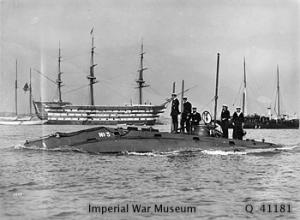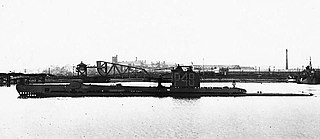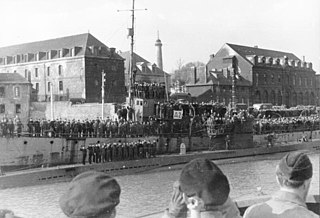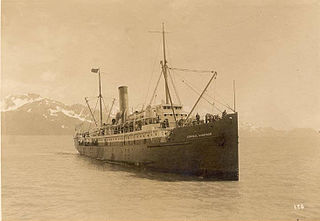Related Research Articles

Thomas Morgan Robertson, known by the stage name Thomas Dolby, is an English musician, producer, composer, entrepreneur and teacher.

HMAS AE1 was an E-class submarine of the Royal Australian Navy (RAN). She was the first submarine to serve in the RAN, and sank with all hands near what is now East New Britain, Papua New Guinea, on 14 September 1914, after less than seven months in service. Search missions attempting to locate the wreck began in 1976. The submarine was found during the 13th search mission near the Duke of York Islands in December 2017.

German submarine U-853 was a Type IXC/40 U-boat of Nazi Germany's Kriegsmarine during World War II. Her keel was laid down on 21 August 1942 by DeSchiMAG AG Weser of Bremen. She was commissioned on 25 June 1943 with Kapitänleutnant Helmut Sommer in command. U-853 saw action during the Battle of the Atlantic in World War II. She conducted three patrols, sinking two ships totalling 5,353 GRT and 430 tons.

USS Crevalle (SS/AGSS-291), a Balao-class submarine, was a ship of the United States Navy named for the crevalle, the yellow mackerel, a food fish, found on both coasts of tropical America, and in the Atlantic as far north as Cape Cod.

"She Blinded Me with Science" is a song by the English musician Thomas Dolby, released in 1982. It was first released as a single in the United Kingdom in October 1982. It was subsequently included on the EP Blinded by Science and the 1983 re-release of Dolby's debut album The Golden Age of Wireless.

The Golden Age of Wireless is the debut album by English musician Thomas Dolby. Originally released in May 1982, the album was reissued in a number of different configurations, with later resequencings including the pop hit "She Blinded Me with Science".

Blinded by Science is an EP by new wave/synthpop artist Thomas Dolby, comprising extended 12-inch single versions of songs from the 1982 album The Golden Age of Wireless. It was released in 1983.

Shadow Divers: The True Adventure of Two Americans Who Risked Everything to Solve One of the Last Mysteries of World War II is a 2004 non-fiction book by Robert Kurson recounting of the discovery of a World War II German U-boat 60 miles (97 km) off the coast of New Jersey, United States in 1991, exploration dives, and its eventual identification as U-869 lost on 11 February 1945.

Holland 5 was the last of the five Holland-class submarines ordered by the British Admiralty to evaluate the potential of the submarine with the Royal Navy. She was one of the first submarines to be accepted into Royal Navy service, and unique to her class, she carried one of the earliest periscopes. By the time she was launched, a number of A-class submarines had already been ordered to replace this class in navy service.

HMS P48 was a Royal Navy U-class submarine built by Vickers-Armstrong at Barrow-in-Furness. Commissioned on 18 June 1942, Vickers arranged for the wife of serving submarine Captain, Alister Mars of HMS Unbroken, Ting Mars and Commander of the cruiser Jamaica to officially launch P.48 at Barrow dockyard.
SM UB-65 was a Type UB III U-boat of the Imperial German Navy during World War I. Ordered on 20 May 1916, the U-boat was built at the Vulkan Werke shipyard in Hamburg, launched on 26 June 1917, and commissioned on 18 August 1917, under the command of Kapitänleutnant Martin Schelle.

German submarine U-123 was a Type IXB U-boat of Nazi Germany's Kriegsmarine that operated during World War II. After that conflict, she became the French submarine Blaison (Q165) until she was decommissioned on 18 August 1959.

German submarine U-701 was a Type VIIC U-boat built for the Nazi Germany's Kriegsmarine that served in the North Atlantic during World War II. It was launched on 16 April 1941 under the command of Kapitänleutnant Horst Degen, with a crew of 43.
SM UC-44 was a German Type UC II minelaying submarine or U-boat in the German Imperial Navy during World War I. The U-boat was ordered on 20 November 1915 and was launched on 10 October 1916. She was commissioned into the German Imperial Navy on 4 November 1916 as SM UC-44. In 6 patrols UC-44 was credited with sinking 28 ships, either by torpedo or by mines laid. UC-44 was sunk by the detonation of one of her own mines off the Irish coast at position 52°07′N6°59′W on 4 August 1917; its commander, Kurt Teppenjohanns, was the only survivor. UC-44's wreck was raised by the Royal Navy in September 1917 and later broken up.

Innes McCartney is a British nautical archaeologist and historian. He is a Visiting Fellow at Bournemouth University in the UK.

"Europa and the Pirate Twins" is a song by English artist Thomas Dolby, from his 1982 album The Golden Age of Wireless. Written by Dolby, who produced it alongside Tim Friese-Greene, the song was released as a single on 24 August 1981.
German submarine U-576 was a Type VIIC U-boat of Nazi Germany's Kriegsmarine during World War II. She carried out five patrols, sinking four ships of 15,450 gross register tons (GRT) and damaging two more of 19,457 GRT. She was sunk on 15 July 1942 by depth charges from two US aircraft and gunfire from a merchant ship, near the East Coast of the United States. The wreck was discovered in August 2014.

The SS Admiral Sampson was a U.S.-flagged cargo and passenger steamship that served three owners between 1898 and 1914, when it was rammed by a Canadian passenger liner and sank in Puget Sound. Following its sinking off Point No Point, the Admiral Sampson has become a notable scuba diving destination for advanced recreational divers certified to use rebreathing equipment.
The following index is provided as an overview of and topical guide to Wikipedia's articles on recreational dive sites. The level of coverage may vary:

Recreational dive sites are specific places that recreational scuba divers go to enjoy the underwater environment or for training purposes. They include technical diving sites beyond the range generally accepted for recreational diving. In this context all diving done for recreational purposes is included. Professional diving tends to be done where the job is, and with the exception of diver training and leading groups of recreational divers, does not generally occur at specific sites chosen for their easy access, pleasant conditions or interesting features.
References
- ↑ J, Andy (2004-01-21). "Andy J's Guide to Thomas Dolby". Archived from the original on October 18, 2009. Retrieved July 13, 2011.
- ↑ Dolby, Thomas (February 2, 2018). "Thomas Dolby - Posts". Facebook.
- ↑ "HMS P 48 (P 48)". uboat.net.